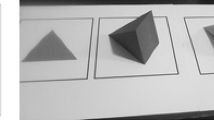Abstract
Knowledge of the difficulties involved in processing deformable objects is necessary if learning activities are to be devised which develop visualisation skills in spatial aspects of mathematics. The research reported here attempts to determine an ordering in terms of complexity of tasks involving the mental manipulation of deformable objects, tasks which require the same skills as those employed in mathematical imagery.
Subjects performed a series of spatial tests involving the comparison of diagrams of interlaced ropes, or knots at varying orientations. Knots were chosen not only because there is a mathematical structure to describe their properties but also, since they are deformable, the tasks differ from those in earlier work based upon the rotation of rigid objects.
Results indicated that certain knot shapes are processed faster than others and, as with rigid objects, greater relative rotation of one of the deformable shapes increases the decision time. Tasks with more crossings were predicted to be of higher complexity, and to require longer decision times. However, this was found not to be the case, particularly where strong bilateral symmetry existed which significantly reduced decision time.
Similar content being viewed by others
References
Battista, M. T.: 1990, ‘Spatial visualisation and gender differences in high school geometry’,Journal for Research in Mathematics Education,21(1), 47–60.
Bell, A. W., Costello, J. and Michemann, D.: 1983,Research on Learning and Teaching, Part A, NFER Nelson, Windsor.
Bishop, A.: 1980, ‘Spatial abilities and mathematics education — a review’,Educational Studies in Mathematics 11, 257–269.
Clements, M. A.: 1981, ‘Visual imagery and school mathematics’,For the Learning of Mathematics 2(2), 2–9 and 2(3), 33–39.
Clements, D. H. and Battista, M. T.: 1992, ‘Geometry and spatial reasoning’, in Grouws, Douglas A. (ed),Handbook of Research on Mathematics Teaching and Learning, Macmillan and National Council of Teachers of Mathematics, New York.
Cooper, L. A. and Shepard, R. N.: 1990, ‘Turning something over in the Mind’, in R. R. Llinas,The Workings of the Brain — Readings from Scientific American, Freeman.
Dawe, L.: 1993, ‘Visual imagery and communication in the mathematics classroom’, in M. Stephens, A. Waywood, D. Clarke and J. Izard (eds),Communicating Mathematics: Perspectives from Classroom Practice and Research, Australian Council for Educational Research, Hawthorn, Victoria, pp. 60–76.
Gates, P.:Working Mathematically with Mental Imagery with Third Formers, PM64C Open University video.
Gates, P.: 1988 ‘Working mathematically on circles and imagery’,Mathematics Teaching 124, 21–23.
Harper, E. et al.: 1988,NMP — Mathematics for Secondary Schools Red Track Book 3 Longman Group UK.
Kosslyn, S. M.: 1980,Image and Mind, Harvard University Press, Cambridge, Mass.
Kosslyn, S. M.: 1994,Image and Brain, MIT Press, Cambridge, Mass.
Krutetskii, V. A.: 1976,The Psychology of Mathematical Abilities in School Children, University of Chicago Press, Chicago.
Lean, G. and Clements, M. A.: 1981, ‘Spatial ability, visual imagery, and mathematical performance’,Educational Studies in Mathematics 12, 267–299.
Mason, J.: 1988, ‘Imagery, imagination and mathematics classrooms’, in Pimm, David, (ed)Mathematics, Teachers and Children, Hodder and Stoughton/Open University, London.
Mason, J.: 1992, ‘Doing and construing mathematics in screenspace’, in B. Southwell, B. Perry and K. Owens (eds),Space the First and Final Frontier, Proceedings of the Fifteenth Annual Conference of the Mathematics Education Research Group of Australasia, University of Western Sydney.
McLeay, H.: 1991, “Mathematics and knots”,Mathematics in School 20(1), 28–31.
McLeay, H.: 1994,The Knots Puzzle Book, Tarquin Publications, Stradbroke, England.
Piaget, J., Inhelder, B. and Szeminska, A.: 1960,The Child's Conception of Geometry, Routledge and Kegan Paul, London.
Presmeg, N.: 1986, ‘Visualisation in high school mathematics’,For the Learning of Mathematics 6(3), 42–46.
Shepard, R. N. and Metzler, J.: 1971, ‘Mental rotation of three-dimensional objects’,Science 171, 701–703.
Wheatley, G.: 1991, ‘Enhancing mathematics learning through imagery.’Arithmetic Teacher 39(1), 34–36.
Author information
Authors and Affiliations
Rights and permissions
About this article
Cite this article
McLeay, H., Piggins, D. The mental manipulation of 2-D representations of knots as deformable structures. Educ Stud Math 30, 399–414 (1996). https://doi.org/10.1007/BF00570831
Issue Date:
DOI: https://doi.org/10.1007/BF00570831




